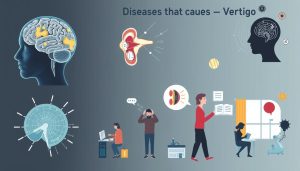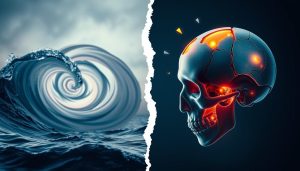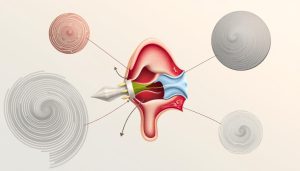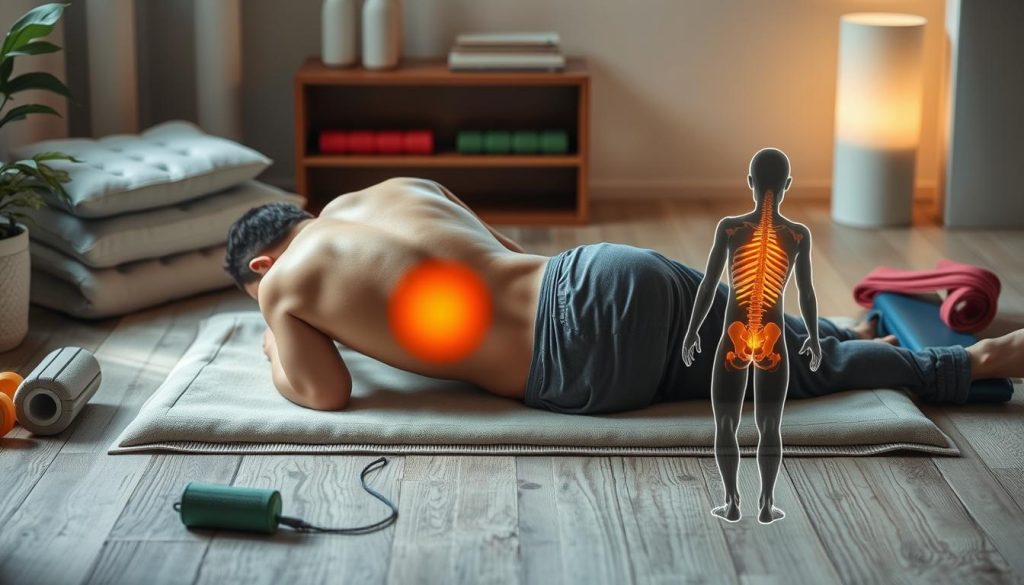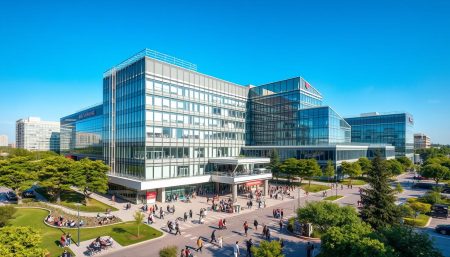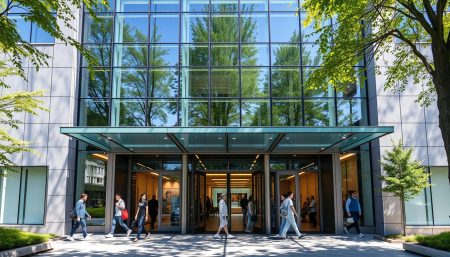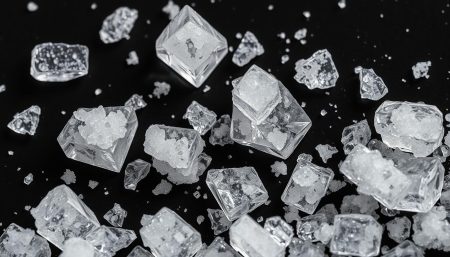Pain Bottom Left Back Life’s pace can make back pain worse, affecting our comfort and movement. Many solutions exist to help you feel better. This part of our series aims to guide you through back pain relief.
We’ll explore various ways to ease your pain. These methods promise to improve your life, one step at a time.
We’ll cover quick fixes, lifestyle changes, and professional help. Our goal is to help you manage back pain effectively. We aim to make your life pain-free.
Understanding Pain Bottom Left Back Causes
Exploring left lower back pain reveals a wide range of causes. These include skeletal and muscular issues. Understanding these triggers helps us manage pain more effectively.
Common Etiologies of Left Lower Back Pain
Left lower back pain can stem from many sources. Muscular strains, often from overexertion or bad posture, are common. Herniated discs can also cause pain by pressing on the sciatic nerve.
Kidney problems can lead to sharp pains in the left lower back. These pains differ from the dull ache of muscle or bone issues. It’s important to identify these causes for proper treatment.
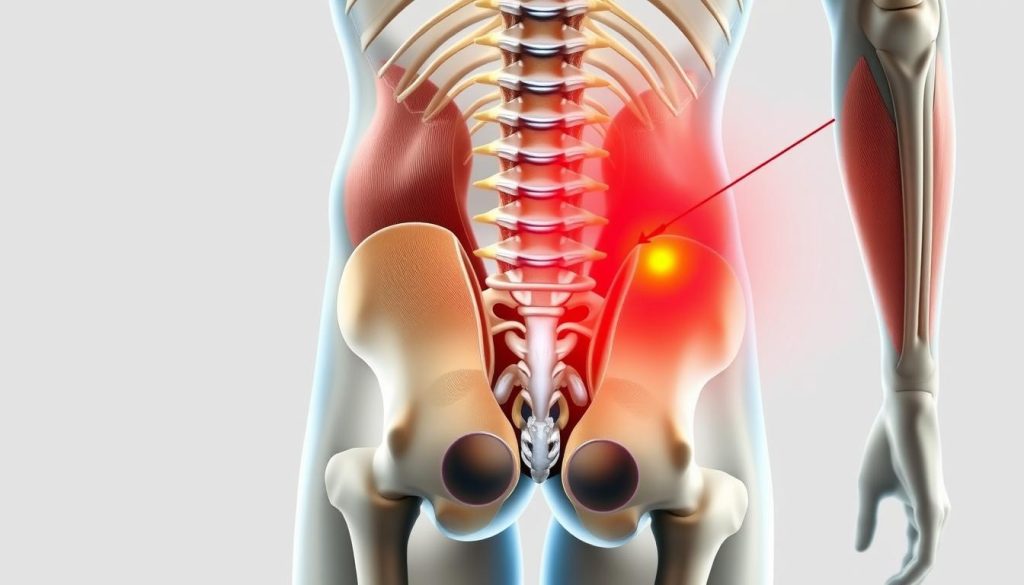
Anatomy of the Lower Back
The lower back, or lumbar region, is made up of bones, joints, nerves, ligaments, and muscles. These parts work together to support the body and allow movement. Problems in any of these can cause pain, showing why understanding their connection is key.
Understanding Referred Pain Mechanisms
Referred pain is a complex phenomenon. It happens when pain in one area comes from another part of the body. For example, problems in the pancreas or kidneys can cause pain in the lower back. This makes it hard to pinpoint the source of pain.
Assessment of Lower Back Ache Intensity
Understanding how to manage lower back ache starts with knowing its severity. This helps in creating pain management plans that work well for each person.
Measuring Pain: Tools and Scales
Pain measurement tools help both patients and doctors measure lower back ache intensity. The Visual Analogue Scale (VAS) and the Numeric Pain Rating Scale (NPRS) are top choices. They help track pain levels, setting a starting point for treatment.
| Scale | Description | Measurement Range |
|---|---|---|
| Visual Analogue Scale (VAS) | A horizontal line where the patient marks their pain level from ‘no pain’ to ‘worst imaginable pain’. | 0 to 10 |
| Numeric Pain Rating Scale (NPRS) | Patient selects a number that best reflects the intensity of their pain. | 0 (no pain) to 10 (worst pain) |
When to Seek Professional Advice
Knowing when to see a doctor for lower back ache is key. Look for signs like pain lasting over six weeks, severe pain that stops you from doing daily tasks, or pain with other symptoms like weight loss or fever. These are reasons to get medical help.
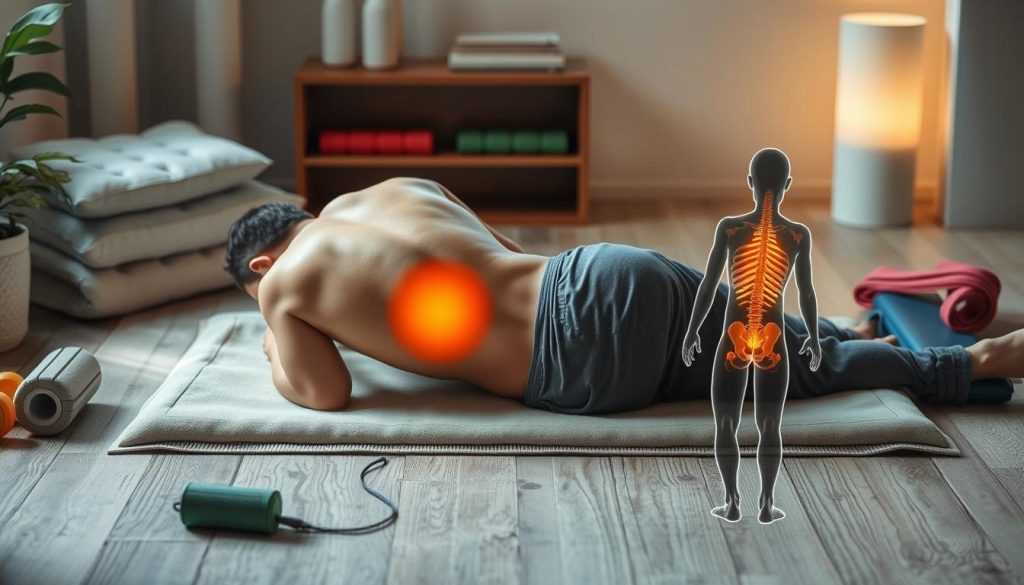
Immediate Actions to Alleviate Left Lower Back Pain
Left lower back pain can really hurt and make it hard to move. It’s important to find fast ways to feel better. This section will show you how to start managing and treating back pain right away.
Putting heat or ice on the sore spot is a good first step. But, it’s important to know when to use each one:
- Heat therapy: Use a heating pad or warm towel to relax tight muscles and improve blood flow to your lower back.
- Ice therapy: Use a cold pack wrapped in a towel to reduce swelling and dull sharp pain.
Changing how you sit and stand can also help a lot:
- Rest your back, but don’t stay in bed too long. Too much rest can make it stiffer and hurt more.
- When sitting, make sure your back is supported, your feet are flat, and your knees are a bit higher than your hips.
- When sleeping, keep your spine’s natural curve. Sleeping on your side with a pillow between your knees can help ease pressure on your lower back.
Here’s a table that shows how rest and activity compare in treating left lower back pain:
| Method | Effectiveness | Recommendation Duration |
|---|---|---|
| Complete Rest | Low | Not recommended beyond 48 hours |
| Moderate Activity | High | As tolerated, with intermittent rest |
Starting these steps right when pain hits can help you feel better fast. It can also stop long-term problems.
Home Remedies for Back Pain
Looking into natural remedies for back pain can be very helpful. These options are great for those who don’t want to use invasive treatments. We’ll talk about some strong home remedies that can help ease back pain.
Natural Anti-Inflammatory Solutions
Back pain often comes from inflammation. Changing your diet and adding certain foods can help. Foods like turmeric, ginger, and omega-3 fatty acids can fight inflammation and ease pain.
Also, using hot or cold compresses on the painful area can quickly soothe it.
Evidence-Based Homeopathic Techniques
Homeopathic remedies are sometimes questioned, but they can help with mild back pain. Using Arnica Montana, a well-known remedy, on the skin can lessen pain and swelling. Doing gentle stretches and yoga for back pain can also help.
- Include anti-inflammatory herbs like turmeric and ginger in meals.
- Apply hot or cold packs to the affected areas to reduce pain.
- Consider topical applications of Arnica for muscle pain and stiffness.
- Practice yoga poses that enhance back muscle strength and flexibility.
By trying these homeopathic and natural treatments, people with back pain can see big improvements. This can greatly improve their life quality.
Physical Exercises for Lower Back Pain
Doing structured exercises is key for back pain relief and managing lower back pain. This guide shows you exercises to strengthen your back, improve flexibility, and ease pain.
These exercises work for all fitness levels. They help keep your spine healthy and prevent future pain.
- Partial Crunches: Builds strength in the lower back and stomach muscles.
- Hamstring Stretches: Enhances flexibility in the back through the elongation of leg muscles.
- Wall Sits: A good starter exercise that minimizes strain while working the lower back and leg muscles.
- Press-up Back Extensions: Helps in the realignment of the spine and relieves pressure on the discs.
- Knee to Chest: A gentle way to stretch the hips and back while improving mobility.
Remember, don’t strain or rush these exercises for the best back pain relief. Here’s a table with simple steps for each exercise. This ensures you can do them correctly and safely.
| Exercise | Steps | Repetitions |
|---|---|---|
| Partial Crunches | Lie on your back with knees bent and feet flat, cross arms over chest, tighten stomach muscles and raise your shoulders off the floor. | 10-12 |
| Hamstring Stretches | Lie on your back, bend one knee, loop a towel under the foot of the extended leg, and pull back gently towards your body. | Hold for 15-30 seconds, 2-4 times each leg |
| Wall Sits | Lean back against a wall with feet shoulder-width apart, then slowly slide down into a squat position. | Hold for 10 seconds, 8-12 times |
| Press-up Back Extensions | Lie on your stomach, place your hands under your shoulders, and push your upper body rising half-way in a cobra pose. | Hold for 5 seconds, 10 times |
| Knee to Chest | Lie on your back and pull one knee up to your chest while keeping the other leg straight and flat on the floor. | Hold for 15 seconds, 2-4 times each leg |
Adding these exercises to your routine can greatly help manage lower back pain and achieve lasting back pain relief. Always talk to a healthcare professional before starting any new exercise, even if you’re not in severe pain.
Pain Management Strategies for Chronic Back Pain
Managing pain is key for those with chronic back pain. It impacts daily life and overall well-being. This section looks at ways to help manage pain long-term and improve daily activities.
Physical therapy is a top choice for chronic back pain. It strengthens muscles and boosts flexibility. This reduces the strain on the spine and lowers pain.
Psychological methods, like cognitive-behavioral therapy (CBT), also play a role. They help change how people think about pain. This empowers them to handle their pain better.
| Strategy | Description | Expected Benefit |
|---|---|---|
| Physical Therapy | Includes exercises and stretches to strengthen back muscles. | Reduces pain through physical strength and flexibility enhancement. |
| Cognitive-Behavioral Therapy | Focuses on altering negative thoughts related to pain. | Improves pain coping strategies and mental well-being. |
| Pharmaceutical Options | May include non-steroidal anti-inflammatory drugs or muscle relaxants. | Provides temporary relief from intense pain episodes. |
Using a mix of these methods, along with medication as advised by doctors, can greatly help. It tackles both physical and mental aspects of pain. This can lead to better pain control and less need for medication.
Over-the-Counter Medications for Temporary Relief
Many people look for quick fixes for lower back pain without seeing a doctor. They often turn to over-the-counter (OTC) medications. Knowing the different types of OTC medications is key for managing mild to moderate back pain treatment.
Understanding NSAIDs and Analgesics
NSAIDs and analgesics are top choices for back pain relief. NSAIDs, like ibuprofen and naproxen, help with pain and reduce swelling. Analgesics, such as acetaminophen, mainly focus on pain relief without affecting swelling. The right choice depends on the pain type and any health conditions.
Responsible Self-Medication Tips
Safe self-medication is key for effective pain management. Always follow the dosage and know the risks of long-term use. People with health issues should talk to a doctor first. Adding lifestyle changes from trusted sources like health guidance platforms can boost the effect of OTC drugs.
| Medication Type | Pain Relief | Inflammation Reduction | Common Side Effects |
|---|---|---|---|
| NSAIDs | Yes | Yes | Stomach upset, increased risk of heart attack or stroke |
| Analgesics | Yes | No | Liver damage with excessive use |
Understanding the strengths and limits of OTC medications helps tailor back pain treatment and pain management. This ensures both quick relief and responsible use of these healthcare options.
Lifestyle Adjustments for Back Pain Treatment
Making certain lifestyle changes is key to managing back pain. Knowing how our daily habits affect our spine health is important. It helps in finding relief and treating back pain for the long term.
The Role of Diet and Nutrition
Eating a balanced diet is vital for back pain management. It helps reduce inflammation and strengthens the bones and muscles around the spine. Foods like fish and flaxseeds, and vitamins like Vitamin D, are good for musculoskeletal health.
- Fruits and Vegetables: Rich in antioxidants which reduce oxidative stress and inflammation.
- Whole Grains: Lower the incidence of lower back pain by improving overall bodily function and weight management.
- Lean Proteins: Essential for muscle repair and growth, critical for those with back pain.
Importance of Proper Posture
Keeping the right posture is key to avoiding back strain. Bad posture can make back pain worse or cause new problems.
- While sitting: Feet should be flat on the floor, and your back should be against the chair. Avoid slouching or leaning forward.
- While standing: Spread your weight evenly on both feet and bend your knees slightly. This relieves pressure on your lower back.
- While lifting objects: Always bend your knees and squat, lifting with your legs instead of your back.
These simple changes can greatly help in treating back pain. They not only relieve pain but also make your back stronger and healthier over time.
Professional Therapies for Pain Bottom Left Back
Looking into professional therapies can really help with pain in the bottom left back. These include physiotherapy and chiropractic care. They are designed to meet the needs of those with chronic or acute back pain. They focus on getting better and reducing pain.
Physiotherapy Techniques
Physiotherapy uses many ways to make the back stronger and move better. After checking you out, a physiotherapist might suggest exercises for your lower back. They might also use ultrasound, electrical stimulation, and manual therapy to help your muscles and reduce pain.
Chiropractic Care Options
Chiropractic care aims to fix the spine, which often causes lower back pain. Chiropractors make precise adjustments to help your posture and spinal mechanics. This can really help with pain. You might get spinal manipulation, mobilization, and advice on keeping your back right.
| Treatment Type | Goals | Typical Techniques |
|---|---|---|
| Physiotherapy | Strengthen back muscles, enhance mobility | Exercise, manual therapy, electrical stimulation |
| Chiropractic Care | Correct spinal alignment, improve posture | Spinal adjustment, mobilization |
If you’re searching for remedies for back pain, trying these therapies together might help a lot. Always talk to health experts to create a back pain treatment plan that fits your needs and pain level.
Alternative Treatments and Holistic Approaches
Looking into complementary therapies can really help with back pain relief and managing lower back ache. These non-traditional methods offer a wide range of options. They focus on pain and improve overall health.
Acupuncture and Acupressure
Acupuncture and acupressure come from traditional Chinese medicine. They are known for treating pain, including lower back pain. By using specific body points, these methods can ease muscle tension and boost blood flow. This can lead to a lot of back pain relief.
Exploring Aromatherapy and Essential Oils
Aromatherapy uses essential oils from plants for healing. Lavender, eucalyptus, and peppermint are favorites for easing pain and swelling in the lower back.
Here’s a look at some popular essential oils and their benefits for back pain relief:
| Essential Oil | Benefits | Application Method |
|---|---|---|
| Lavender | Reduces inflammation, eases muscle tension | Topical application, diffusion |
| Peppermint | Natural analgesic, muscle relaxant | Topical application with carrier oil |
| Eucalyptus | Anti-inflammatory, pain relieving properties | Steam inhalation, topical application |
Adding these alternative treatments to your routine can be a great way to complement traditional methods. They might make other treatments work better and offer a more holistic approach to back pain relief.
Advanced Pain Management Techniques
For those with chronic back pain, advanced pain management can help a lot. This part talks about some top-notch options for patients and doctors to consider.
Methods like nerve blocks, radiofrequency ablation, and spinal cord stimulation stand out. Each has its own use and can really help improve life for those with bad back pain.
- Nerve Blocks: This method involves injecting an anesthetic near nerves to block pain signals. It’s used for both diagnosis and long-term pain relief.
- Radiofrequency Ablation: This uses radio waves to heat up nerves, temporarily stopping pain signals. It can give relief for six to twelve months.
- Spinal Cord Stimulation: A device is implanted to send electricity to the spinal cord. It’s used when other treatments don’t work.
Before trying these methods, it’s key to talk to pain management experts. They can help figure out the best approach and discuss risks and benefits. Decisions should be based on a full check-up to help manage chronic back pain effectively.
Ergonomic Devices to Support Lower Back
Ergonomic devices are key for back pain relief and pain management. The right support in your environment can lessen lower back strain. This improves comfort and aids in healing. There are many ergonomic furnishings and gadgets that can help your spine health.
Choosing the Right Furniture for Back Support
For furniture that helps with back pain, look at ergonomic chairs and mattresses. Ergonomic chairs support your spine’s natural curve. They often have adjustable parts for different body sizes. Mattresses that support and comfort right can also prevent back pain by keeping your spine aligned while you sleep.
- Adjustable lumbar support in chairs
- Memory foam or latex mattresses that modify to the contours of the body
Assistive Products for Mobility and Comfort
There are also many assistive products for better mobility and comfort with lower back pain. Items like ergonomic seat cushions, back supports for car seats, and standing desks are very helpful. They help keep your back in a good position all day.
- Ergonomic seat cushions that distribute weight evenly
- Stand-up desks that encourage movement and relieve pressure on the lower back
Using these ergonomic solutions daily can help with back pain relief and improve your overall well-being. They can make a big difference in your office, home, and even in cars. Every place can be made to support your spine and help with pain management.
The Psychological Impact of Chronic Back Pain
Living with chronic back pain is more than just physical pain. It affects your mind too. The ongoing pain can cause emotional distress, impacting your mental health and life quality. It’s key to understand this link for better pain management.
Chronic back pain creates a cycle of pain and stress. Stress makes pain worse, and pain increases stress. It’s vital to tackle both the mental and physical sides of pain to break this cycle.
Coping Mechanisms and Stress Reduction
It’s important to find ways to manage stress from chronic pain. Mindfulness, meditation, and cognitive behavioral therapy are helpful. These methods help change negative thoughts and improve your mood.
- Mindfulness helps you live in the moment and accept pain without judgment.
- Meditation can reduce pain by calming your mind and body.
- Cognitive Behavioral Therapy (CBT) helps change harmful thinking patterns to better manage emotions and pain.
Adding these techniques to your daily life can help with both pain and mental strain. This is important for those dealing with chronic back pain.
Pain Bottom Left Back: The Connection Between Mind and Body in Pain Management
The mind and body are connected in pain management. Understanding this is key for those with chronic conditions. Stress relief activities improve mental health and help reduce physical pain.
Regular exercise, staying connected with others, and getting enough sleep are practical steps. These support both your mental and physical health. They are essential for a holistic approach to managing chronic back pain.
It’s just as important to treat the mental effects of chronic back pain as the physical. Effective pain management should include both mental and physical treatments. This ensures a complete approach to health and well-being.
Pain Bottom Left Back: When Surgery Is an Option: Discussing Last Resort Treatments
Many cases of chronic back pain can be managed with various treatments. But, some cases may need more serious steps. Surgery is considered only when all other options have been tried and failed.
This choice is for those with severe symptoms that make daily life hard. It’s also for people with clear structural problems that surgery can fix.
Surgical options for chronic back pain range from discectomies to fusion surgeries. Each procedure targets specific issues like herniated discs or spinal instability. It’s important to discuss the benefits and risks with a healthcare professional.
Thinking about surgery can be scary. But knowing what to expect can help. Understanding the procedure, recovery, and post-surgery care can offer some comfort.
Recovery from back surgery is key. Patients will get advice on post-operative care. This may include physical therapy, activity restrictions, and lifestyle changes.
The goal is to ease pain and improve function and mobility. This way, people can get back to their daily lives. This article aims to help readers make informed decisions about their health.
Pain Bottom Left Back: FAQ
Q: What are some initial steps I can take for pain bottom left back relief?
A: For quick relief, try using a cold pack to cut down on swelling or a heat pad to ease muscle tension. Gentle stretching and over-the-counter pain meds like ibuprofen can also help. But don’t stay too long without moving, as this can make the pain worse.
Q: What causes pain in the bottom left area of the back?
A: Pain in the bottom left back can come from muscle strain, herniated discs, or kidney issues. Bad posture and too much use can also cause discomfort.
Q: How can I measure the intensity of lower back ache?
A: You can use scales like the Visual Analogue Scale or the Numeric Pain Rating Scale to measure pain. These tools help track and treat pain consistently.
Q: What are some home remedies for back pain?
A: Home remedies include using heat or ice packs, doing yoga or gentle stretches, and sitting right. Eating foods and taking supplements with natural anti-inflammatory properties can also help.
Q: Can physical exercises improve my lower back pain?
A: Yes, exercises that strengthen the core, improve flexibility, and posture can help with lower back pain. It’s key to do these exercises right and often for the best results.
Q: What strategies are there for managing chronic back pain?
A: Managing chronic back pain often means using a mix of treatments. This includes physical therapy, exercise, pain meds, and sometimes nerve blocks or radiofrequency ablation.
Q: Are over-the-counter (OTC) medications effective for treating back pain?
A: OTC meds like NSAIDs and acetaminophen can help with back pain. But, it’s important to follow the dosage and watch for side effects.
Q: How can lifestyle adjustments help with my back pain treatment?
A: Changing your lifestyle can greatly help with back pain. This includes eating better, managing your weight, quitting smoking, and sitting right. These changes can improve your spinal health a lot.
Q: What professional therapies are available for pain bottom left back?
A: Professional therapies include physiotherapy and chiropractic adjustments. Physiotherapy offers tailored exercises and manual therapy. Chiropractic adjustments aim to correct spinal alignment and reduce pain.
Q: Can alternative treatments offer relief for left lower back pain?
A: Alternative treatments like acupuncture, acupressure, and aromatherapy might help some people with back pain. But, their effectiveness can vary, and they should be used alongside other treatments.
Q: What advanced pain management techniques are available?
A: Advanced pain management includes treatments like epidural steroid injections, nerve blocks, and radiofrequency ablation. In some cases, spinal cord stimulators are used to reduce chronic back pain.
Q: How can ergonomic devices support my lower back and prevent pain?
A: Ergonomic devices like supportive chairs, standing desks, and special pillows can help keep your back in the right position. They can prevent pain by providing the right support.
Q: What psychological impact does chronic back pain have and how can I manage it?
A: Chronic back pain can lead to depression and anxiety. To cope, try therapy, stress reduction, and mindfulness. These can help improve your mental and physical health.
Q: When is surgery considered for left lower back pain?
A: Surgery is usually a last resort for back pain. It’s considered when other treatments don’t work or if there’s a specific problem like a herniated disc. A specialist will need to evaluate if surgery is right for you.




